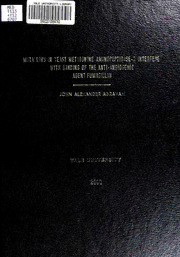
Mutations in yeast methionine aminopeptidase-2 Interfere with binding of the Anti-angiogenic Agent Fumagillin PDF
Preview Mutations in yeast methionine aminopeptidase-2 Interfere with binding of the Anti-angiogenic Agent Fumagillin
YALE UNIVERSITY LIBRARY YALE UNIVERSITY CUSHING/WHITNEY MEDICAL LIBRARY Permission to photocopy or microfilm processing of this thesis for the purpose of individual scholarly consultation or reference is hereby granted by the author. This permission is not to be interpreted as affecting publication of this work or otherwise placing it in the public domain, and the author reserves all rights of ownership guaranteed under common law protection of unpublished manuscripts. Signature of Author Date Digitized by the Internet Archive in 2017 with funding from Arcadia Fund https://archive.org/details/mutationsinyeastOOabra Mutations in Yeast Methionine Aminopeptidase-2 Interfere with Binding of the Anti-angiogenic Agent Fumagillin A Thesis Submitted to the Yale University School Of Medicine in Partial Fulfillment of the Requirements for the Degree of Doctor of Medicine by John Alexander Abraham YAlf ISfWdW tffllARY JUl 21 20Q0 * Med Liio '7113 •f Yi Abraham, John Page 1 ABSTRACT The ability of tumors to induce angiogenesis, or new blood vessel formation, is critical to their growth and spread. As a result, factors which inhibit angiogenesis are targets for cancer therapy. One anti-angiogenic agent, TNP 470, is derived from a compound, fumagillin, which induces cell cycle arrest specifically in endothelial cells. Fumagillin has been shown to inhibit the action of a metalloprotease, methionine aminopeptidase-2 (MetAP-2), which is found in both endothelial and non-endothelial cell types. A crystal structure of MetAP-2 with bound fumagillin has recently been solved, which suggests that there are several residues of MetAP-2 in close approximation to fumagillin. These residues may be important in determining specificity of the drug for this enzyme. It was thus hypothesized that by mutating these residues using site-directed mutagenesis, it may be possible to generate mutant versions of MetAP-2 resistant to fumagillin binding. The results presented here demonstrate that three such mutations, G341D, G341S, H339F have been identified. These mutations confer resistance to 10 nM, 5nM, and InM concentrations of fumagillin, respectively, which would normally inhibit wild type MetAP-2. If endothelial cells expressing these mutations are resistant to the cell-cycle arrest normally induced by this drug, it constitutes significant functional evidence that the anti-angiogenic effect of this drug can be attributed to its specific interaction with MetAP-2.
